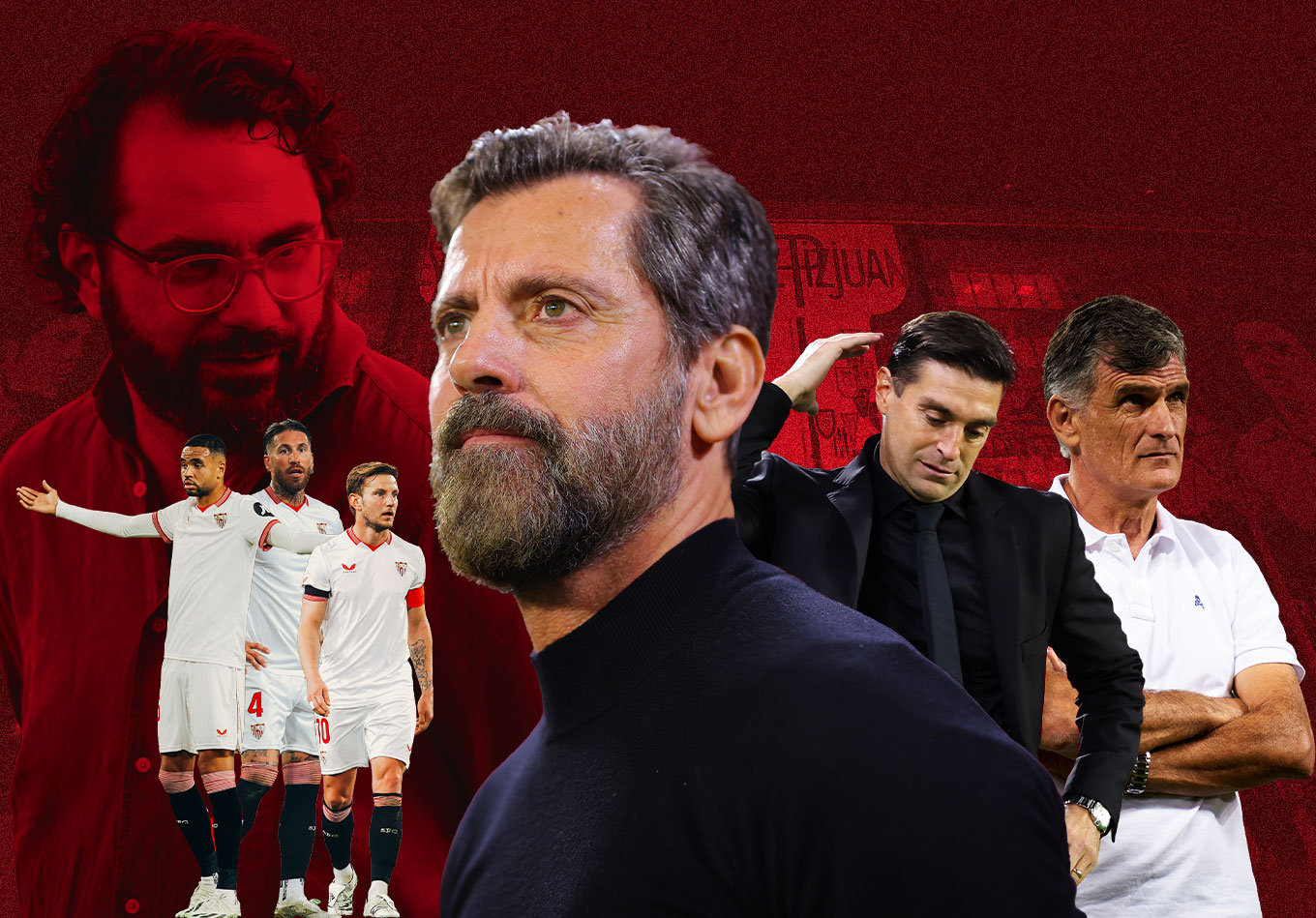Between 2019 and 2022, Sevilla recorded three successive top-four La Liga finishes for the first time in 65 years; now, they’re facing the possibility of a relegation battle. We looked at their dramatic decline and what they’re doing in their attempts to climb away from trouble.
There was a time – quite a long time in fact – quite recently when Sevilla were up there with the best-run clubs in Europe. They were the masters of buying cheap, maximising players’ abilities and selling for significant profit, or cutting out the buying part altogether and promoting from their brilliant academy, which has been a major source of income over the past two decades.
This brought on-pitch success as well, but the man behind much of that is gone, with sporting director Monchi moving to Aston Villa last summer after bringing his second spell at the Ramón Sánchez Pizjuán to an end. He left behind an old, underperforming and expensive (in terms of wages) squad; the outlook is now far bleaker than it was just 18 months ago, with genuine fear setting in regarding the possibility of relegation.
After last Friday’s 3-2 home defeat to Alavés, Sevilla ended Matchday 20 just a point above the bottom three. They’ve managed as many La Liga wins this season as they’ve had head coaches (three) and lost more games (10) than all but three other clubs in the division.
Their points tally of 16 is their joint-third worst at this stage of a La Liga campaign (counting three points per win) – the last time they had 16 or fewer from their first 20 matches was in 1967-68 (13), when they were relegated.
Furthermore, since the start of the 2012-13 season, only eight clubs (excluding 2023-24) have had exactly 16 points after 20 games – and five of them went down.
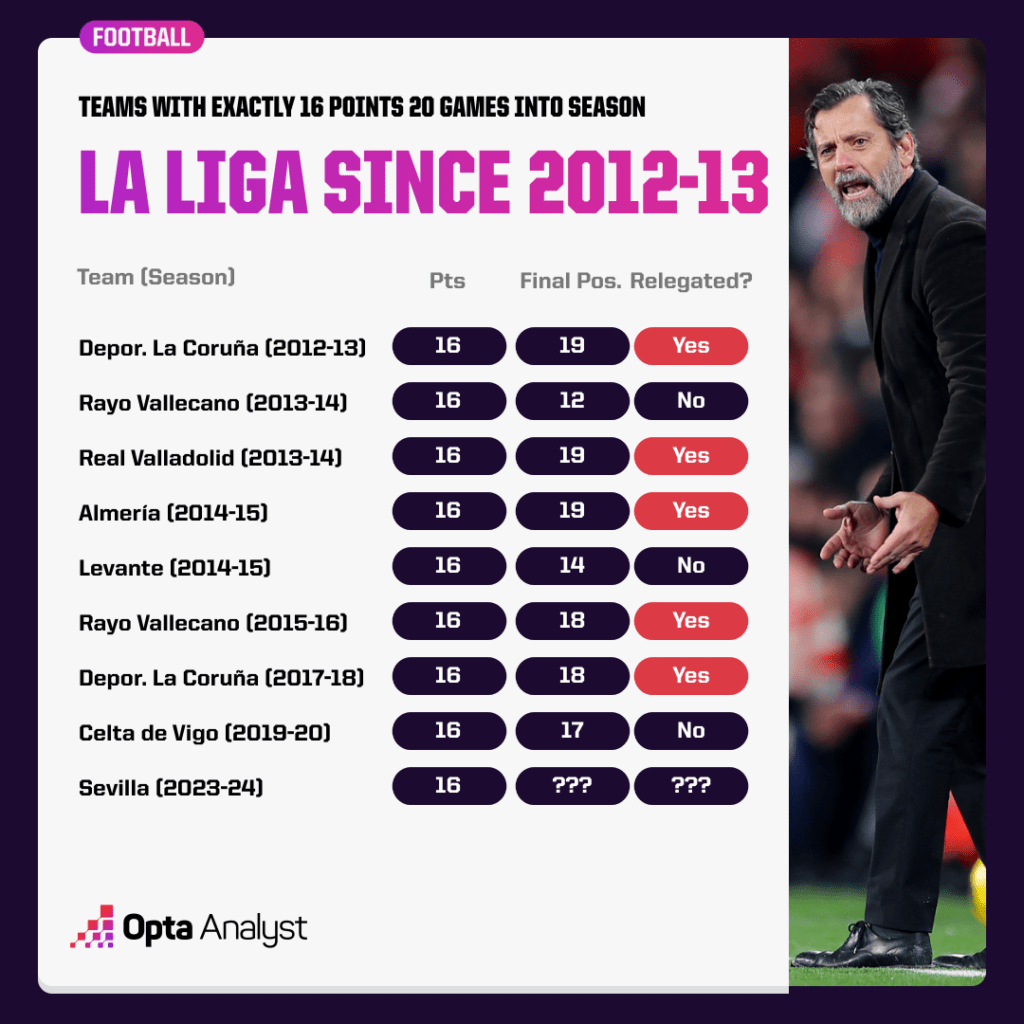
Sevilla are fortunate there have been three teams worse than them this season – two of them considerably so – with Granada (11 points) and winless Almería (six points) already looking doomed.
Nevertheless, relegated in 16.5% of the Opta supercomputer’s latest 10,000 simulations at the time of writing, Sevilla’s position is hardly one of strength.
So, that’s the situation they find themselves in.
The question is, how?
It essentially began with Monchi’s return to Sevilla in 2019 after a brief and unsuccessful spell with Roma. His plan was to turn Sevilla into genuine title challengers, so although there was still a desire for some players with re-sale value, they set their limits a little higher. Their ambition also saw them turn to more players about to hit their peak years or those who boasted significant experience.
Maximum short-term impact rather than long-term investment was the idea in many cases, with players like Fernando, Luuk de Jong, Ivan Rakitic, Papu Gómez, Marcos Acuña, Thomas Delaney, Jesús Corona, Anthony Martial, Alex Telles, Isco and Érik Lamela brought in between 2019 and 2022. A few made decent contributions, a couple delivered great value, but most would be considered mistakes or disappointments.
The excellence of Julen Lopetegui and the brilliant defence he had for three seasons arguably made Sevilla look better than the sum of their parts as they finished in the top four three years in a row for the first time since the 1950s, having a very good stab at challenging for the title in the process. In 2020-21, they pushed the big boys hard and then looked like Real Madrid’s only credible threat in the first half of 2021-22.
In Jules Koundé and Diego Carlos, they had one of the best centre-back partnerships in Europe in front of the dependable Yassine Bounou; not only were they fundamental to how the team played out from the back, but the solidity they helped establish meant Sevilla didn’t need to be a free-scoring side.
For instance, from August 2019 to June 2022, 32 teams across the top five leagues scored more than Sevilla (160 – 53.3 per season), but of all the clubs to spend more than one year in those competitions in that period, only Real Madrid (84), Paris Saint-Germain (88), Manchester City (93) and Atlético Madrid (95) conceded fewer than Lopetegui’s men (97). Similarly, City (57) and Madrid (52) were the two teams to keep more clean sheets than Sevilla (51) over those three seasons.
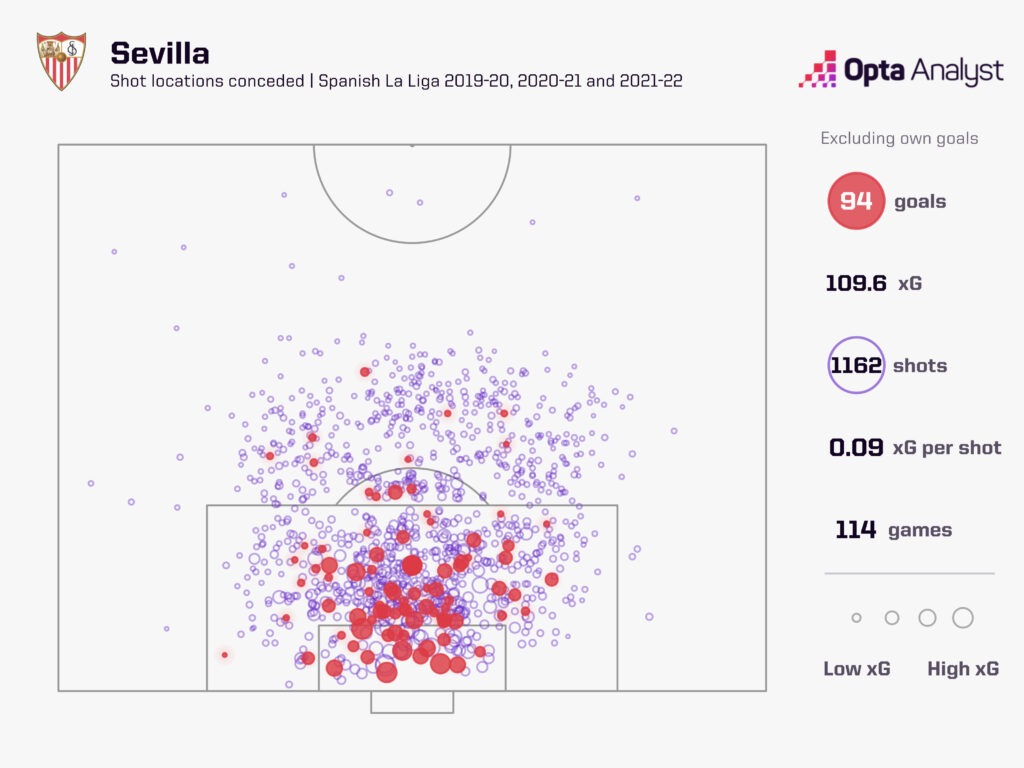
They knew Koundé and Diego Carlos would leave eventually and the chances of replacing either with a centre-back of a similar level but much cheaper were small; the likelihood of doing so for both in the same summer was remote, so when those two departed in the pre-season of 2022, the team crumbled.
Sevilla lost the foundation around which their whole team was built, and so their brief flirtation with title challenges was firmly over. As their attacking numbers suggested, especially in the second half of 2021-22 when their title tilt quickly wilted, they needed to offset the decrease in their defensive solidity by improving their quality going forward; Kasper Dolberg joined on a loan deal that was terminated at the end of December 2022 after failing to score a single goal, Isco signed but had his contract terminated before Christmas following a row with Monchi, and Adnan Januzaj made one La Liga start before being loaned to Istanbul Basaksehir in January 2023 and Sevilla are still reportedly trying to get him off the books. He continues to await his first goal.
In terms of attacking reinforcements, that was it, and the rolling expected goals (xG) average chart below highlights how rarely since the start of last season that their attacking threat has outweighed their defensive deficiencies.
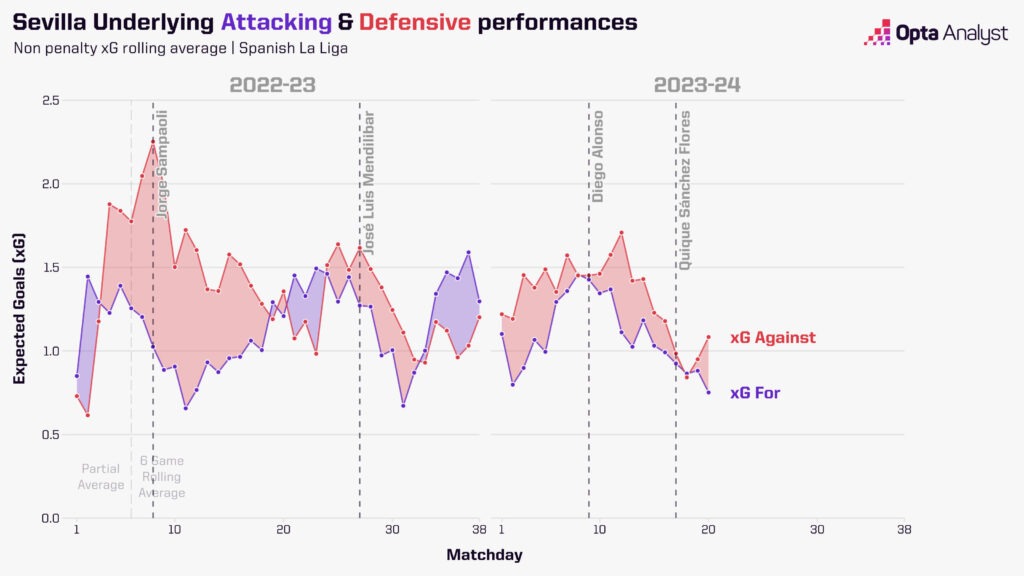
Hindsight is 20/20, sure, but none of those players made an adequate impression, so Lopetegui was fighting a losing battle from the start of the 2022-23 season. The team’s issues were compounded by the struggles of the centre-backs brought in to replace Koundé and Diego Carlos. Tanguy Nianzou largely looked out of his depth last term, to the extent that he’s only played three times in La Liga this season; Marcão has managed just eight league appearances in total due to almost constant injury problems.
The upheaval culminated in a dreadful start to 2022-23 that saw Lopetegui sacked after one win in their first 10 games across all competitions. Jorge Sampaoli replaced him for his second spell at the club but they never got much better, with murmurings of player discontent regarding the complicated nature of his tactical instructions. He was sacked in March 2023 with Sevilla just two points above the relegation zone.
It was verging on miraculous that Sampaoli’s replacement, proverbial firefighter José Luis Mendilibar, steered them comfortably clear of the bottom three and guided Sevilla to their record-extending seventh UEFA Cup/Europa League title. Given where they are now, it remains utterly mystifying.
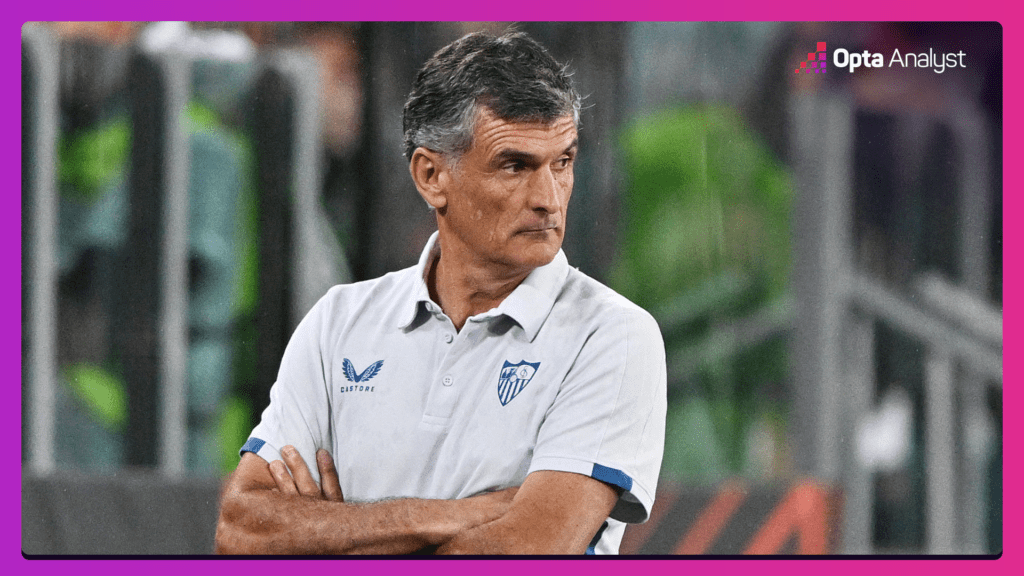
Of course, Mendilibar didn’t last long either. His direct, back-to-basics football quickly wore thin and, considering he was the pick of Monchi, it wasn’t particularly surprising to see new sporting director Victor Orta – whose spell at Leeds United ultimately left a bad taste for fans – bring in a manager of his own.
However, it begged the question as to why they didn’t part with Mendilibar – who was never likely to be a long-term fit regardless of Europa League success – in the summer at the end of his short-term contract when they’d apparently lined up the highly rated Marcelo Gallardo to take over. As harsh as it sounds on Mendilibar, it would’ve been a clean break, an opportunity to start a new era afresh.
When Mendilibar was dismissed in September after only two wins from their first 11 games in all competitions, Gallardo had already gone to Saudi Arabia. Orta plumped for Diego Alonso, which always looked a curious decision. His last club job had been an unimpressive stint with Inter Miami, then he failed to get Uruguay out of their group at the 2022 World Cup. It was also seemingly a bone of contention between the board and sporting director at the time, with president Pepe Castro and vice-president José María del Nido Carrasco filmed at the training ground appearing to share their misgivings with Orta.
Their concern, and that of the fans, was justified. Sevilla’s commitment to playing predictable cross-and-hope football due to a dearth of creative options in the centre of the pitch got even greater, with them now the only club in La Liga this season to see less than 20% of their chances created come from the middle third (19.5%). Funnily enough, it isn’t a strategy that’s yielded lots of positive results.
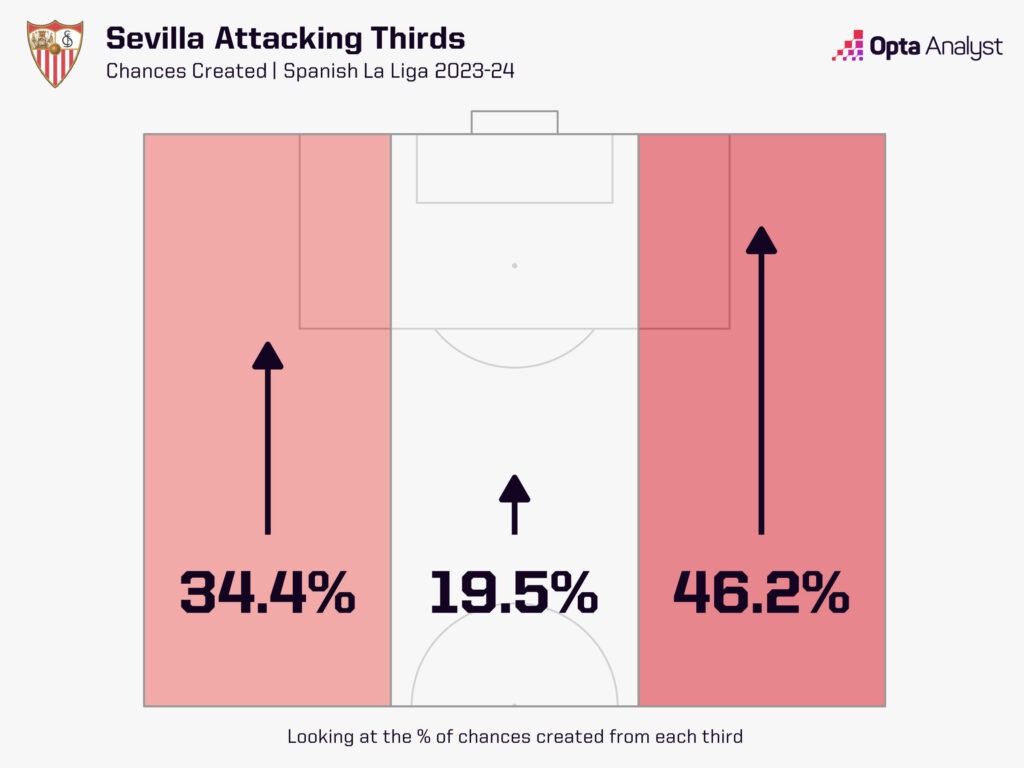
Alonso didn’t win a single La Liga game during his time in charge, becoming only the second coach in the club’s history to record no victories in his first eight top-flight games as boss. He also became only the second coach in La Liga history to draw his first four La Liga matches.
Suffice to say, there was no ‘new manager bounce’. Quique Sánchez Flores was next in the door; another uninspiring choice for many, but their options were limited and at least he could boast considerable experience coaching in Spain.
And that brings us to January 2024, with Sevilla travelling to league leaders Girona on Sunday just a point above Cádiz in the last relegation place. At this stage, not even the most arrogant of supporters would suggest they’re not in a fight for survival, with a first relegation in 24 years looking concerningly possible. Of all ever-present La Liga clubs since the start of 2022-23, only Almería (47), Cádiz (57) and Celta Vigo (60) have won fewer points than Sevilla (65).
As such, they’ve plummeted in the Opta Power Rankings, going from 14th in July 2022 to 74th this week.
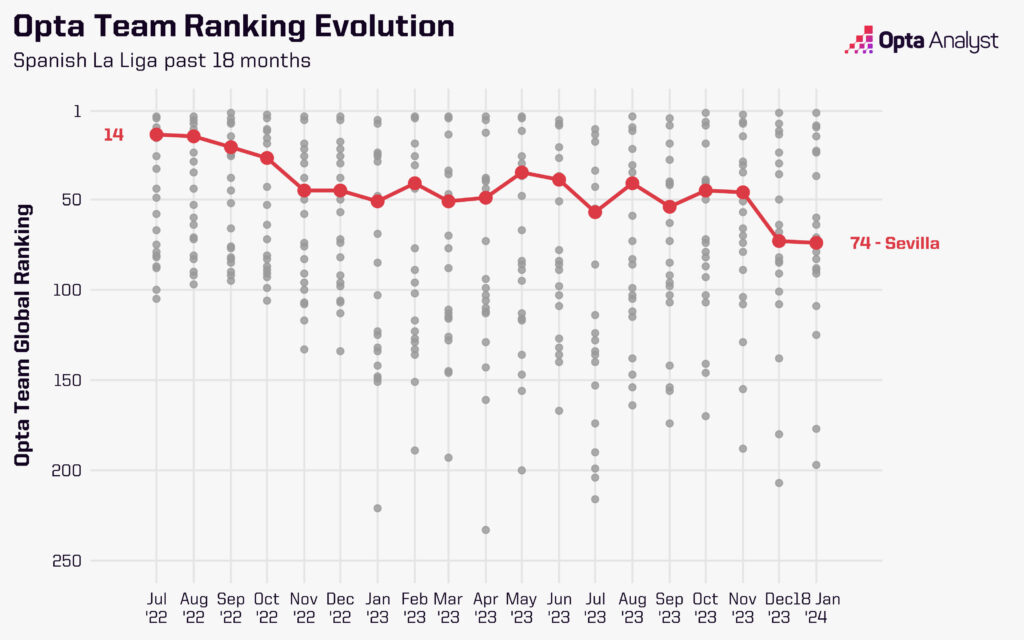
The situation has forced them to revert to some of the recruitment principles that helped shape what has been a golden era for the club over the past two decades. The players Orta – who worked under Monchi for seven years from 2006 – has turned to this month are young, and one of them is from the academy.
Isaac Romero had to be patient in stepping up from the second team, Sevilla Atlético. A serious injury stopped him in his tracks during the 2021-22 season, but the striker showed signs of promise last term and scored 11 goals in 15 games for Sevilla Atlético before the turn of the year. Fans had been calling for the 23-year-old to be brought into the first team for months, but registration rules meant that was only possible in January if a member of the senior squad left. Fernando, 36, brought his fine spell at the club to an end and returned to Brazil, allowing the homegrown forward to step up; his decisive brace in Tuesday’s 3-1 Copa del Rey defeat of Getafe nudged Rafa Mir closer to the exit.
The players Orta has signed this month have all been even younger than Isaac. Lucien Agoumé (21, loan with option to buy), Mateo Mejía (20), Stanis Idumbo Muzambo (18) and Hannibal Mejbri (20, loan with option to buy). In one sense it’s refreshing because Sevilla have needed an injection of youthful exuberance for a few years. Their starting XI in November’s 3-2 defeat to PSV had an average age of 32 years and 19 days, making it the oldest line-up in Champions League history, and they’ve also named the oldest team in La Liga this term (31y, 127d vs Valencia).
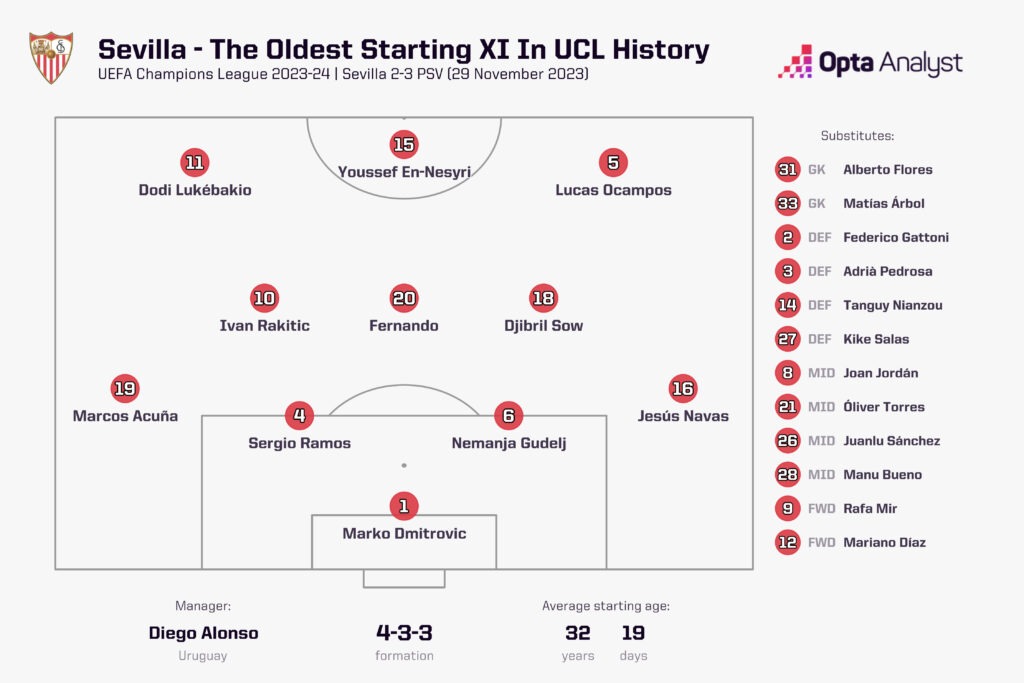
But Orta turning to youth appears to be more out of necessity than design. The senior side has little room for manoeuvre in terms of their salary limit, and they’ve no space to register players because they’re struggling to offload the likes of Joan Jordán, Lamela, Óliver Torres, Januzaj, Mariano Díaz and Mir, meaning all of their new young recruits have instead been registered with the B team. They can still play for the senior side because they’re all under the age of 23, but the situation is far from ideal particularly given they had to terminate the contract of homegrown goalkeeper Alfonso Pastor to make room for Hannibal’s wages in Sevilla Atlético’s budget.
There’s clearly a potential upside to going for younger talents, but it also stinks of poor planning and desperation; after all, if the club’s idea all along was to introduce significantly more young players then Sevilla probably wouldn’t have allowed Carlos Alvárez, their most talented youth product in over a decade, to join Levante for free (plus 50% of his next transfer fee) in the summer.
So, unless there are some major outgoings that facilitate more movements in the last two weeks of the January transfer window, the new faces Sevilla are hoping can be the difference between relegation and safety are a handful of young players. Talented young players, granted, but largely inexperienced and unproven, with Mejía and Idumbo set to start off with the B team.
Perhaps it’s the beginning of a return to their roots, all part of a necessary cultural reset that sees them back at Spanish football’s top table in a few years. Either way, right now it feels like the road back will be far, far longer than the shortcut they took from title challengers to relegation battlers.
Enjoy this? Subscribe to our new football newsletter to receive exclusive weekly content. You should also follow our social accounts over on X, Instagram, TikTok and Facebook.
